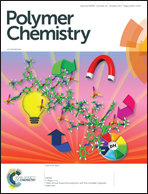Anion exchange membranes by bromination of tetramethylbiphenol-based poly(sulfone)s
Abstract
Anion exchange membranes (AEM) with tunable properties were synthesized via bromination of poly(ether sulfone)s containing tetramethylbiphenol (TMBP) comonomers, followed by bromination, quaternization, and ion exchange. The bromination reactions of poly(ether sulfone)s containing TMBP and tetramethylbisphenol A (TMBA) comonomers were assessed in terms of the composition of the polymers and the molar equivalents of N-bromosuccinimide (NBS). Compared with TMBP-based polymers, TMBA-based poly(sulfone)s were more susceptible to degradation during bromination due to the degradation of the isopropylidene linkage in TMBA under radical conditions, resulting in a weight average molecular weight decrease of 31–43% after bromination. The decrease of molecular weights also became more pronounced when the equivalents of NBS was raised. Polydispersity after bromination increased for both TMBP- and TMBA-based polymers because of side reactions such as branching, crosslinking, and chain scission. For a given ion exchange capacity, the conductivity and water uptake of TMBP-based AEMs were lower than those of the TMBA-based samples, which can be attributed to the relatively rigid TMBP residue. AEMs in this study retained 40–62% of their original conductivity after degradation in 1 M NaOH solution at 90 °C for 500 hours.



 Please wait while we load your content...
Please wait while we load your content...